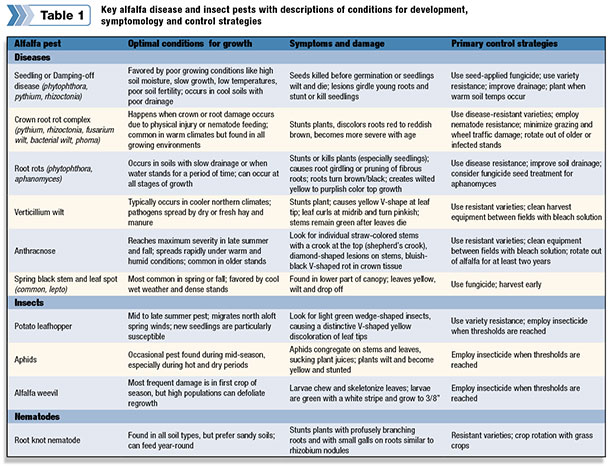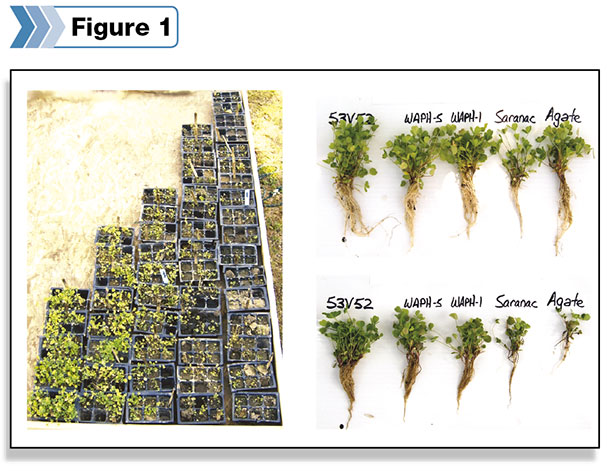Join the club. You are not alone in your disdain for alfalfa diseases and insects. Invisible disease organisms sit in waiting until the perfect environment exists to indiscriminately infect your alfalfa plants. Insects seem to appear out of nowhere and then reproduce faster than the speed of light to aggressively feed on your crop. Both disease and insect damage can lead to significant loss of production, reduced forage quality and early stand loss.
Taking the pest challenge head on
Tackling alfalfa disease and insect challenges is best accomplished using three tactics: genetic resistance, chemical control products and crop management practices. These can be used as single line-of-defense solutions or in a combination strategy.
Winning against alfalfa pests starts by knowing several key things:
• What alfalfa disease and insect pests are most likely found on your soils and in your region?
• What conditions are ideal for developing alfalfa diseases or for attracting insects?
• What are the symptoms of disease or insect feeding?
• How quickly can a disease or insects spread and inflict economic damage?
• When do you need to take action and what strategies most effectively prevent or control alfalfa disease and insect pests?
Table 1 provides this information for key insect pests and diseases of alfalfa.

Your first line of defense is genetics
Genetic resistance can help you avoid an uphill battle when disease or insect pressure strikes. Since the 1980s, breeders have developed alfalfa varieties with resistance to several major diseases and insect pests. This has given alfalfa producers a new level of control and reduced the risk of alfalfa damage or failure.
Several key diseases include bacterial wilt, verticillium wilt, fusarium wilt and anthracnose, along with phytophthora and aphanomyces (race 1 and 2) root rots.
Each disease is evaluated using standardized tests and then characterized for five levels of disease resistance: susceptible, low resistance, moderate resistance, resistant and highly resistant. The disease resistance index helps identify overall risk for the most common alfalfa diseases.
While no alfalfa variety can exhibit 100 percent resistance to a disease, the best alfalfa varieties offer levels of resistance of more than 50 percent (highly resistant) for the seven diseases tested. Several varieties also have been bred with high levels of tolerance to potato leafhoppers and nematodes.
The first picture shows seedlings grown from two alfalfa varieties with different levels of resistance to aphanomyces and phytophthora root rots. In this screening test, the highly resistant variety has more plants that survive and thrive under root rot pressure than the low-resistance variety.

In the second picture, five alfalfa varieties with different levels of resistance to phytophthora and aphanomyces are grown in soils exhibiting a high level of root rot disease activity versus no root rot disease activity.
Chemistry is your friend to help fight alfalfa pests
Sometimes genetic disease or insect resistance is not a viable choice. Genetic resistance may be unavailable, incomplete or enhanced by another management strategy. Chemical fungicides and insecticides provide another tool for managing loss due to alfalfa pests.
The most susceptible time for alfalfa injury or death is during seedling germination, emergence and early development. Young, immature plants are easily infected or damaged, leading to stunted growth and death. Along with genetic resistance, seed treatments containing fungicides protect seedlings during this early growth stage.
One of the key seedling diseases for which there is no genetic resistance is pythium. In this case, only a fungicide will provide protection from this organism. If planting an alfalfa variety with minimal resistance to a disease, there may be a fungicide seed treatment available to aid in the protection of the plants.
Foliar leaf and stem diseases have been around for many years, and little to no genetic resistance is available in modern alfalfa varieties. Recent introduction of foliar fungicides help growers protect alfalfa leaves and stems from excessive damage.
While these fungicides prevent leaf defoliation due to leaf and stem disease, the yield benefits remain variable at best. Some growers have reported as much as a 20 percent yield response from the application of a foliar fungicide.
University trials in Wisconsin and Minnesota during 2012 showed five of 14 (35 percent) positive yield responses for fungicide application. Similar responses were shown in an Iowa State University study.
Growers looking to maximize alfalfa yield and quality should consider various tools to protect this valuable crop. Foliar fungicides may be part of your management program. In growing environments conducive to high incidence and severity of leaf disease, fungicides may help to protect yield and offer an economic advantage.
Managing to reduce stress
Growing a disease-free and insect-free alfalfa crop starts with good genetics and proper chemical control. However, it is aided by great crop management and harvest techniques. Several key management factors help to prevent or minimize alfalfa pests. These include management practices like the following:
• Harvest timing – Relieve high insect pressure by harvesting several days early, avoiding the use of an insecticide, then monitoring regrowth for insect activity.
• Minimal delay between cutting and harvesting – It helps prevent wheel traffic damage to re-growth or delayed regrowth under windrows.
• High fertility and proper soil pH – Nutritionally healthy plants fight disease better.
• Early and complete weed control – Even a nurse crop can be a stress to alfalfa seedlings, causing long-term damage.
Will drones and satellites scout your fields?
Technology continues to change our lives. This is true in the world of agriculture as well. In the near future, remote monitoring with drones or satellites will likely be available to scout your fields.
These exciting technologies will be able to monitor plant growth, giving real-time data on plant health, nutrition and stress status as well as tracking insect movement into your region.
In the meantime, finding out about disease and insect problems requires boots on the ground. In-field scouting helps you identify problems before they become serious or untreatable. It also helps you make key decisions to protect your farm’s forage inventory and quality.
If you don’t have time to scout, the small investment in a trained scout who can regularly monitor your fields is easily paid for with the timely control of a single insect outbreak.
Every pound of alfalfa on every acre of your farm is grown to drive high milk production and animal performance. Maximizing production of this high-protein crop helps keep feed costs in check and offers a highly digestible fiber source for the dairy animal.
Knowing the disease and insect issues you might encounter and how to manage them is key to growing this valuable crop on your farm. PD

Dan Wiersma
Livestock Information Manager
DuPont Pioneer






